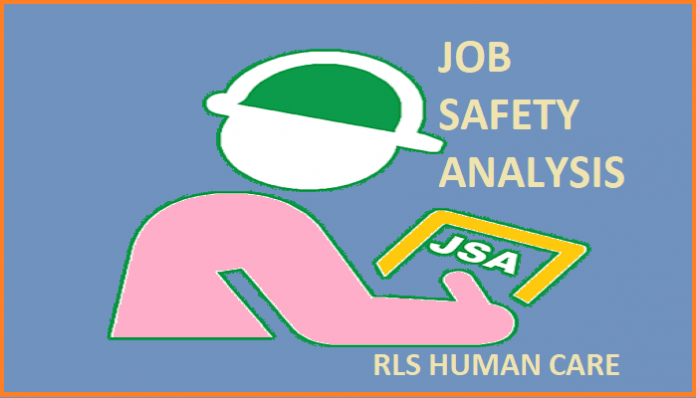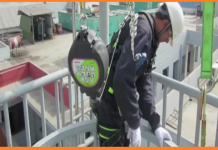Contents
Procedure for Job Safety Analysis (JSA)
What is JSA?
JSA FOR CONSTRUCTION SITE
It is a tool intended to analyze each step of a task for hazard assessment followed by recommendations of actions/procedure (s) that will eliminate or reduce the workplace hazards including the risk of injury, illness, fire & explosion.
Job Safety Analysis is a safety management tool for identification and control of hazards associated with a particular job by
Systematic/safely approach to start any activity
- Drilling down the job into simple steps.
- Identifying the hazard associated with each step and
- Suggesting the control measure for each hazard.
WHY JSA FOR CONSTRUCTION SITE?
Many workers are injured or killed at the workplace every day. Ensuring the safety and health of employees is very critical to jobs and businesses. You can prevent workplace injuries and illnesses by looking at your workplace operations, establishing proper job procedures, and ensuring that all employees are trained properly.
Job Safety Analysis (JSA) is a basic tool for safety planning which is another way of preventing workplace injuries. This technique allows us to observe the job, think through the steps involved and discuss how to complete the job safely.
CLICK HERE FOR 👉 HIRA
What Jobs are Appropriate for a JSA?
Job Safety Analysis shall be performed for all critical tasks, irrespective of nature i.e. routine or non-routine.
Priority for the jobs to be covered by JSA can be as follows.
- Job Safety Analysis shall be performed for all kind of jobs/ tasks, irrespective of nature i.e. routine or non-routine that has a potential to cause injury or fatality. If Standard Operating Procedures (SOP) of routine jobs are available, JSA may be avoided, however copy of Standard Operating Procedures to be attached along with the work permit copy. All the clearances to be issued ensuring SOPs and the same to be signed by permittee and issuer at site. GSI to mention clearly in permit, whether JSA is required or not.
- Jobs with the highest injury / illness rates / Near miss/ Fire / Explosion incidents reported.
- Jobs with the potential to cause severe or disabling injuries or illness or fire or explosion.
- Jobs in which one simple human error could lead to a severe accident, injury, fire or explosion.
- Jobs that are new to operation or have undergone changes in processes and procedures.
- Jobs complex enough to require written instructions.
- Infrequent jobs –complex in nature such as erection of equipment / facilities with use of cranes / hot work / work at height / entry into confined space/ excavation etc., Hydro-testing / hydro-jetting etc.
- Hot works inside battery area of running units.
Who is Responsible for doing JSA?
Plant Engineers/ Managers / Sectional Head / Area in-charge will be responsible to carry out Job Safety Analysis of all activities in respective units/areas involving engineers from Mechanical, Electrical, Inspection, Process, ES, F&S, HS&E, Project, Instrumentation & Civil maintenance departments, in a multidisciplinary approach, as applicable and record the observations in standard format at least one day in advance.
Engineering assistance may also be involved in JSA. The contractor supervisor may also be involved, if required. All JSA sheets are to be signed by the multidisciplinary team members and follow the recommended safety measures while executing the jobs.
The team should comprise of maximum six persons, however, it may increase occasionally. Completed JSA sheets shall be preserved by respective plant/area managers for future reference.
Plant in-charge to obtain a nomination from section heads of concerned dept. for the formation of the JSA team.
The contractor person may be involved for carrying out JSA if required. In the case of specific jobs, they have a better experience of work and they can contribute to JSA.
CLICK HERE FOR 👉 OIL AND GAS SAFETY OFFICER INTERVIEW
Team carrying out JSA should comprise of :
- Supervisors-Frontline Personnel responsible for the job.
- Employee/Person most familiar with job.
- Safety Professional and/or Engineers/Technical Advisor.
- Contractor supervisor/ contractor worker.
| SN | Activity | Responsibility |
| 1. | Call for JSA and coordination with committee members | Plant In-charge |
| 2. | Presence of EAs/ Supervisors/ workers of executing agency at the site during JSA | Respective Executer |
| 3. | Compilation of JSA Recommendations & Signature of members | Plant In-charge |
| 4. | Review and Signature | HOD of Operation Department and HOD of Concerned Maintenance Department |
| 5. | Attaching a copy of JSA with work permit | Executer |
| 6. | Toolbox talk regarding JSA hazards & precautions | Executer |
| 7. | Compliance to work permit conditions and JSA recommendations at the site throughout the job | Issuer and executer |
| 8. | Filling “Compliance status” in JSA sheet as “Complied/ Not Complied” by Executer with name and signature | Executer |
Details about Job Safety Analysis Procedure
HOD of Operation Department & HOD of Concerned Maintenance Department will review and sign the JSA observation sheets for all critical jobs and ensure compliance with recommended safety measures. Compliance of the points emerged out of JSA to be noted in the JSA sheet at site signing on the extreme right column “Complied status”. Respective DGMs/ Fire & Safety will carry out random checking of JSA system compliance, take corrective action, and discuss non-compliances, deviations if any, in weekly RSM / CSM meetings/ MSCM.
JSA must be completed at least one day before the commencement of job.
The recommended safety measures from JSA shall be strictly followed by executing group while executing the jobs.
JSA after assessment, if not done for any job, the reasons for the same (say ” JSA not required”) shall be mentioned on the Work Permit Sheet.
The responsibility for implementing JSA recommendations shall be with the executing department and the Engineers-in Charge (EIC) of the respective jobs. During the course of execution of the job, if new or unforeseen hazards/risks crops up, the job shall be stopped immediately and JSA shall be revised by the JSA team afresh and shall be reviewed by the HOD of the operation department and HOD of the concerned Maintenance Department.
CLICK HERE FOR 👉 SAFETY PLAN
Completed JSA sheets shall be preserved by the respective Plant In-charge, where they were created for future reference and a copy of same will be sent to the Fire & Safety Department for the record. Also, maintain an inventory list of JSA that have been developed in respective areas. The JSA index should include the name of the task, the date the JSA was completed & the date the JSA was last revised.
Before the issue of work permit Job Safety analysis must be carried out and signed copy of JSA format to be attached along with work permit. In the work permit, the relevant JSA number shall be mentioned. During the work in progress, periodic/surprise visit by Plant Engineer/ In-Charge as per need should be ensured and status will be recorded in JSA format.
In case, job is to be carried out in Construction/Project area segregated from the Operations area or Greenfield Project/Construction, JSA shall be prepared by the team of contractor comprising of:
- Site Supervisor/ Engineer of the contract agency.
- RCM responsible for the execution of the job.
- Safety Supervisor/Safety Officer deployed by consultant/ contractor for the job. (Additional person(s) familiar with the job may be included).
- JSA procedure shall be reviewed by the concerned Client engineer & approved by concerned Engineer In-charge from Project / Engineer.
JSA Training
Team members should have undergone training on Job Safety Analysis. To train the members training shall be organized time to time at Training Dept. with help of in-house faculty as well as an external agency.
JSA Audit
Fire & Safety department shall carry out an audit of JSA System compliance in all areas on a quarterly basis and bring out non-compliances, deficiencies, if any, to the notice of higher management. Such observations shall also be presented in monthly Safety meetings in a structured manner for discussion and improvement. This is in addition to a system audit.
METHODOLOGY
Involvement of Employees in JSA
- Employees of a given working area, performing the said job, shall be involved in all phases of the JSA, i.e. from reviewing the job steps / procedures to discussing potential hazards and recommended solutions.
- Among these employees a(or a group) willing & experienced employee(s) should be selected for observation of the task.
- Once an experienced and willing employee(s) has been selected for observation of the said task, the procedure of JSA shall be discussed with the said employee, performing the job.
- Preferably, the job safety analysis team should take field round of the area, where the job is actually to be performed.
- Employees of other working area, who have performed the same task / job, should also be consulted for cross checking of the action steps associated with the Job / task.
- All the outcome of the analysis should be documented in the prescribed format for Job Safety Analysis.
Stages involved in JOB SAFETY ANALYSIS (JSA)
Stage I: Select the Job for JSA.
Stage II: Accident history should be referred, if available. Review the worksite’s history of accidents/ near-misses etc. with the employees or past records. These events are indicators that the existing hazard controls (if any) may not be adequate and deserve more scrutiny.
Stage III: Write sequential procedure/Steps involved in performing a specific job.
Stage– IV: Assessment of potential safety and health hazards associated with each step.[Hazard Analysis]
Stage–V: The recommendation/identification of action(s) / procedures(s) against each step that will eliminate or reduce the risk of a workplace with respect to injury or illness, property, and environment.
Stage VI: JSA review and sign by HOD of operation department and HOD of concerned Maintenance Department
Stage VII: Checking compliance status at the site
Steps and Activities
A given job shall be broken down into sequential steps. Under each step, the actions /activities shall be drilled down. Each action step shall be logical and linked with previous and forward action steps. Validation of the action steps shall be done in consultation with the employee performing the job. The validated job steps shall be written in the Job Safety Analysis Form.
Compliance at site
- Job safety analysis sheet shall be attached to work permit of the job by plant / area engineer or manager i.e. issuer.
- Work permit receiver shall brief the concerned workers / supervisor on JSA hazards & precautions at beginning of each work day during Tool Box Talk (TBT). Site in-charge/ Engineer in-charge shall maintain a record in register about the JSA briefing (content of JSA in short) given and obtain signature of supervisor also.
- Work permit Issuer as well as Executer shall be responsible for checking and complying to work permit conditions and JSA recommendations at site throughout the job. “Compliance status” in JSA sheet shall be filled as “Complied/ Not Complied” by Executer with name and signature
- Record of TBT shall be maintained by Executer.
Sample of JSA
| JOB SAFETY ANALYSIS | JOB TITLE: Chemical Tank Cleaning JSA No. SUPERVISOR: LOCATION: | DATE: mm/dd/yy ANALYSIS PERFORMED BY: REVIEWED BY: |
| STEPS | HAZARDS | RECOMMENDED ACTION & PROCEDURES |
| 1. Determine: a) what is in the tank, what process is going on in the tank and, c) what hazards this can pose. | Explosive gas Improper oxygen level Chemical Exposure Gas, dust, vapor: Irritant Toxic Liquid: Irritant Toxic Corrosive Heated Solid: Irritant Corrosive Moving blades/equipment | Establish confined space entry procedures. Obtain work permit signed by safety, maintenance, and supervisors. Test air by Gas Safety Inspector Ventilate to 19.5% – 23.5% oxygen and less than 10% LEL of any flammable gas. Provide appropriate respiratory equipment – SCBA or Airline Respirator. Provide protective clothing for head, eyes, body, and feet. Provide harness and lifeline. Tanks should be cleaned from outside, if possible. |
| 2. Select and train operators | Operator with respiratory or hurt problem Un-trained operator | Examination by industrial physician for suitability to work. Train operator |
| 3. Set up equipment. | Hoses, cord, equipment tripping hazards. Electrical – voltage too high, exposed conductors. Motors not locked out and tagged | Arrange hoses, cords, lines, and equipment in orderly fashion, with room to maneuver safely. Use ground-fault circuit interrupter. Lockout and tag out mixing motor, if present. |
| 4. Install ladder in the tank. | Ladder slipping. | Secure to manhole top or rigid structure. |
| 5. Prepare to enter the tank. | Gas or liquid in tank. | Empty tank through existing piping. Review emergency procedures. Open tank. Check of Jobsite by safety professionals. Install blanks in flanges in piping to tank (isolate Test atmosphere in the tank by qualified person. |
| 6. Place equipment at tank entry position. | Trip or fall | Use mechanical-handling equipment. Provide guardrails around work positions at tank top. |
| 7. Enter tank. | Ladder – tripping hazard. Exposure to hazardous Atmosphere. | Provide PPE for conditions found. Provide outside helper to watch, instruct, and guide operator-entering tank, with capability to lift operator from tank in emergency |
| 8. Cleaning tank. | Reaction to chemicals, causing mist or expulsion of air contaminant | Provide protective clothing and equipment for all operators and helpers. Provide lighting for the tank (Class I, Div.1). Provide exhaust ventilation. Provide air supply to interior of tank. Frequent monitoring of air in tank. |
| 9. Cleaning up. | Handling of equipment, causing injury. |
CLICK HERE FOR 👉 DOWNLOAD ALL ACTIVITY JSA
To make the JSA process effective, the defined job shall be broken down into sequential steps. Actions/activities for each step shall be logical & linked with previous & forward action steps. All possible hazards associated with each job step shall be deliberated among team members and recorded carefully. JSA recommendations/control measures for each hazard/job step should be validated by team members & recorded in the JSA sheet.
Review of JSA shall be done by HOD of respective Department and HOD of Concerned Department. After review, respective HOD to put his signature with name & date.
The Job shall be carried out with safety precautions as per JSA recommendations. HODs/ Fire & Safety & higher management personnel may also check compliance of JSA recommendations while doing visits & checking of hot jobs during scheduled visits to the unit/area.






please provide the all Operation control procedure mention your HIRA
Dear sir,
I need OHRs Water tank (Bamboo scafolding )installation procedure and SOPs and required HIRA. please I request to you please provide me.